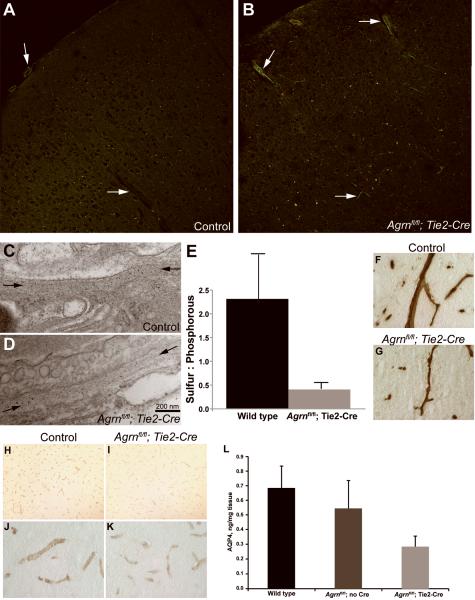Figure 2.
Effects of endothelial cell Agrn deletion on blood-brain barrier composition. (A, B) FITC dextran and sulforhodamine injected intravenously did not enter the brain parenchyma in either control (A) or Agrnfl/fl; Tie2-Cre (B) samples from mice ages 6 months and greater. Arrows denote blood vessels. (C, D) Transmission electron microscopy of cerebral basement membrane on the abluminal surface of endothelial cells (between arrows) in control (C) and Agrnfl/fl; Tie2-Cre (D) mice does not reveal any thinning or breaches in the structural integrity of the matrix. (E) Elemental spectroscopy analysis of the basement membrane revealed a decrease in the ratio of sulfur to phosphorus following endothelial cell Agrn deletion, suggesting that the decrease in AGRIN is not compensated for by an increase in other sulfated proteoglycans. Results are from 8 independent fields examined in each of 2 mice of each genotype. (F, G) Cerebral blood vessels labeled with anti-AGRIN in control (F) and Agrnfl/fl; Tie2-Cre (G) mice demonstrate a reduction in labeling surrounding the vessels, smaller vessel diameters, and more ragged profiles in the Agrnfl/fl; Tie2-Cre samples, consistent with changes in the neurovascular unit in response to endothelial cell Agrn deletion. (H–K) Immunostaining for Aquaporin4 (AQP4) in wild type (H, J) and Agrnfl/fl; Tie2-Cre (I, K) mice demonstrates a marked decrease in immunoreactivity following endothelial cell Agrn deletion. Higher magnification panels (J, K) indicate that the localization of the AQP4 was not changed. (L) An enzyme-linked immunosorbent assay (ELISA) was used to quantify AQP4 in brain homogenates from age and strain matched control mice (n = 6), Agrnfl/fl mice with no transgenic Cre expression (n = 3), and Agrnfl/fl; Tie2-Cre mice lacking endothelial cell Agrin expression (n = 6). Consistent with the reduced staining intensity in immunocytochemistry, AQP4 levels were reduced from 0.68 ± 0.15 ng AQP4/mg of tissue in wild type controls vs. 0.28 ± 0.07 in Agrnfl/fl; Tie2-Cre mice (mean ± SD, t test. p = 0.0002).

